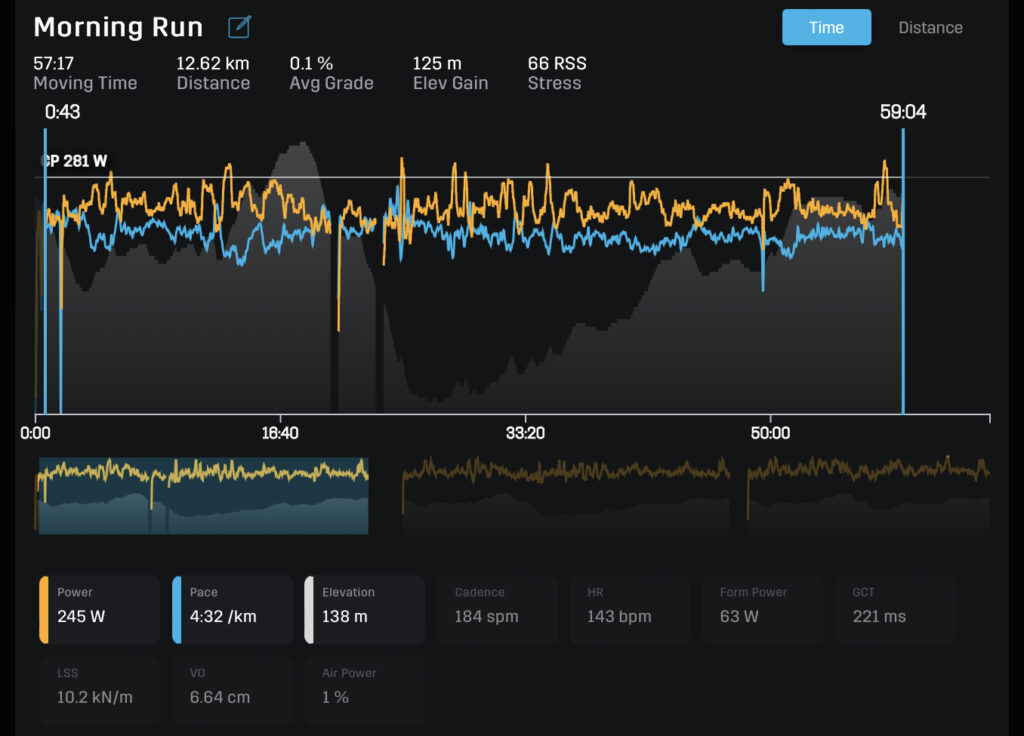16 weeks to go! As I’m writing this, and tallying up another week of training, that’s all that remains. Was this past week a step in the right direction? Let’s take a look at the details, and discover the extent of self sabotage with my stupid training choices.
Weekly Summary
- Total Distance Run: 129 km (80 miles)
- Long Run: 36 km (22 miles) @ 4:27/km (7:10/mile)
- Medium Long Run: 20 km (12.5 miles) @ 4:25/km (7:06/mile)
- Workout: 8 x 1500m @ 3:40/km (5:54/mile) with 60 second recovery
This week rounds off a four week block with increasing training load. Weekly distance is the highest since the lead up to my last marathon. I got through it, but the back half of the week was a struggle.
Thursday was particularly challenging. A high volume day, kicked off with a longer easy run in the morning, I was working hard to get through my medium long run in the evening.
My scheduled—nigh on holy—rest day on Saturday came to the rescue, however. I recovered well between the lunch run on Friday and Sunday morning. That’s why, despite a busy weekend outside of training, I got through the longest run in almost two years without much trouble on Sunday.
Monday
I started the week with the regular menu; two recovery runs. The morning run was with the kid in the stroller, and in the evening I hit the trails to relax a bit. “Unfortunately” the local trail I picked was quite busy with walkers this evening, so I did a bit more on the road than I’d have liked to. No big deal, though—it’s always good to see people out either way!
PS: Same pace on both runs 🎉 A Brady Threlfall daily double special!
Tuesday
By Tuesday morning’s run, my legs were still a bit heavy. I was feeling apprehensive about the big workout on tap for the evening, but giving it a go is never an option.
When I’m not feeling great going into a workout, I find it is especially important to be mindful of keeping the pace controlled at the beginning. With as much as eight 1500 meter reps on the schedule, I wanted to go out around marathon pace, and perhaps work my way down to half marathon pace if I felt decent throughout the workout.
As always, I used the running pace calculator to estimate what that translated to with a new rep distance. I set my sights on around 5:30 as the average.
The numbers show that I went out a bit slower. But I managed to progress the pace, but I didn’t have another gear for the last one or two reps. The heart rate data shows why:
More than half an hour in the threshold zone is a harder workout than what I should be doing with my current approach. With volume as the main driver of training load, you have to run workouts with control.
To me, that means starting out in the moderate zone (zone 3), progressing into zone 4 and the threshold area if you’re feeling good. But any more than 10 to 15 minutes in zone 4 is too challenging. And, although I stayed at the right side of the lactate threshold, I knew during the workout that I was overdoing it. But it’s easy to get carried away, and when running with others you rarely want to relax the pace or call it a day a rep or two earlier than planned.
As we’ll see, though, it cost me later in the week.
Wednesday
The title on this recovery run says it all. Pushing the stroller, feeling anything but relaxed, I was not covering the ground well. Mentally, I was also particularly happy for a night without a double run scheduled.
Thursday
As mentioned last week, Thursdays serve as a second high volume day, in addition to long run Sundays. Eschewing the more traditional second weekly workout, I add in a longer run in the evening after a relatively long (12 km / 7 miles this week) easy run in the morning.
I believe that this approach—combined with a high overall weekly volume—simulates much of the same stimuli as a long run, being slightly less taxing on the body.
These medium long runs are generally challenging. Not so much in terms of cardiovascular endurance, but simply because my legs are tired. As such, my perceived effort is generally quite high compared to what the heart rate indicates on these runs.
That got taken to a new level this week. As I mentioned earlier, I would have to pay a price for going too hard in the workout on Tuesday, and the bill came due this evening.
The heart rate data shows I spent the bulk of the run in zone 1 (recovery), and just about half an hour in the aerobic zone 2. But make no mistake, I was working very hard to get through this run. The only reason I managed to keep the pace up was because I knew that by running faster, it would be over sooner.
This type of heart rate suppression is not uncommon as you’re pushing training load towards the edge of what you can handle. If you’re seeing a similar response, the smart move is to focus on recovering the next few days.
Friday
And recover I did. Although Friday was a bit longer than usual, the run was relaxed and I was starting to feel better again.
Saturday
Full rest day from running.
Sunday
Although I didn’t run on Saturday, it was a busy day overall. Doing some yard work, prepping the outdoor areas for summer, assembling a trampoline 😅 even stretched out way past my ordinary bed time. As a result, I had to adjust the timing of my long run to get some extra sleep in the morning.
That presented an opportunity to practice my race day strategy. I have a pretty clear idea of what I want to do. I’ve had success in the past with a light breakfast consisting of some white bread with jam and two cups of coffee three hours before race start. Practicing your routine, however, is always a good idea. So that’s what I did this morning.
By the time I got out for the run, it was hot, and the sun was scorching. Because of this, I decided to do the run as three big laps from home, to ensure that I could reup on cold water throughout the run.
That strategy paid off, and I handled the heat well enough. But only because I had an adequate supply of cold water. All told, I drank around 1.7 litres of water throughout the run. And I still lost more than a kilogram of body weight!



Feeling better than expected this afternoon led me to my second poor decision this training week. I decided to increase the intensity significantly for the third lap. You can see the stats from each of the three laps in the pictures above, but summarising:
- Lap 1: 245 watts — 4:32/km (7:17/mile)
- Lap 2: 248 watts — 4:28/km (7:11/mile)
- Lap 3: 257 watts — 4:17/km (6:53/mile)
This could have been OK during a normal week. However, in marathon training during a week where you’ve already been struggling because of too much intensity, it is simply too risky.
I got greedy, though, and in doing so I risked the whole training cycle. I should know better, as I have a history of doing too much in marathon training. Going forward, I must make better decisions.
Next week will surely pose more interesting decisions, and challenges. There’s a bit of a down week on the plan, culminating in a half marathon tune-up race on Sunday. Don’t miss out on how it goes. Subscribe to the Run161 Newsletter below!
Most of the stats provided in this report come from Strava. All of my training is public, so feel free to follow me if you want even more frequent training updates.
Like this?
Let me know by sending me an email at lc@run161.com.
